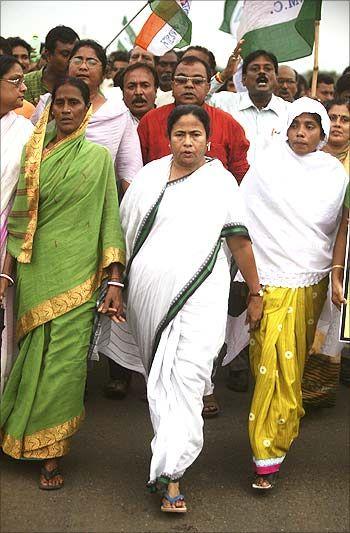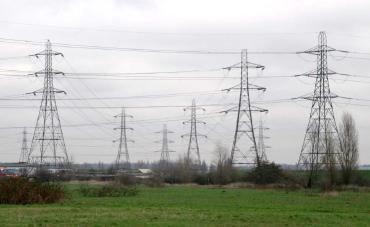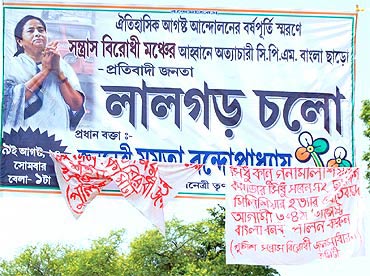
UPA's most vociferous critic may script her own political decline in the state, says Aditi Phadnis
Later this month, Mamata Banerjee will have been chief minister of West Bengal for six months. Time for a balance sheet?
First, all the things she's managed to get done -- only because they are easier to count. She has taken some positive steps to revive the glory of the Presidency College of Kolkata, the institution that has given India some of its best thinkers. She has managed to defuse the Gorkhaland crisis by offering a tripartite agreement, paving the way for the setting up of the Gorkhaland Territorial Administration -- an elected body for the Darjeeling hills.
But most of all, she has managed to establish a reputation as the most vociferous critic of the United Progressive Alliance within the UPA.
When the Centre increased the price of LPG earlier this year, Banerjee first resisted ("the Centre did not take us into confidence..." and so on). Then she took on a mien of martyred indignation ("the state government will bear the burden of the increase in LPG prices") unconcerned about the fact that the state government's finances are in no shape to take on the burden. She threatened to withdraw from the UPA over the current round of petrol price increase, only to recant later.

A Union minister has referred to Banerjee as a compulsive populist. It is hard to dispute this description.
Take her government's attitude towards the price of electricity. West Bengal is considered a role model in power sector reform. The West Bengal State Electricity Board was trifurcated as part of power sector reforms that began in 1985. In 2005-06, the state also corporatised transmission and distribution. There are three power companies in the state now, carved out of the electricity board that together showed a profit of over Rs 300 crore for 2010-11. The government did not privatise: and those employed by power companies (30,000 or so employees) are the only ones to get their salaries regularly because they don't depend on the state government.
But things can change very fast. Demand for power has been rising and so has the price of coal in a state that depends mostly on thermal power. With the massive electoral victory in her pocket, Banerjee could have increased the cost of electricity in the first week of assuming power without any difficulty. Instead, after she took over as chief minister, one of her first meetings was with the power secretary and her bottom line was: electricity prices will not be increased.
In Kolkata, the only area where a private sector entity provides power, the cost of electricity was increased in April 2011 in sync with the cost of coal, and it is likely to increase again. In the summer of 2010, West Bengal had a peak demand shortage of between 500 Mw and 700 Mw, which is expected to go up to between 800 Mw and 1000 Mw this summer. A perfectly healthy sector is going to be driven to sickness: because Banerjee doesn't want to become unpopular.

But what she doesn't realise is her troops are making her extremely unpopular. Somen Mitra, a Trinamool Congress MP, took the unprecedented step of bypassing his own party to complain to Prime Minister Manmohan Singh in a letter about the activities of chit fund operators in Parliament -- an important MP from his own party is a big chit fund "entrepreneur" and was admitted to the TMC by Banerjee only recently.
The biggest problem (although it is not clear if she sees it as such) is: Banerjee is TMC and TMC is Banerjee. Take her handling of the Maoist problem in the Jungle Mahal region. Subhendu Adhikari, described by TMC watchers as the man of the future, organised the TMC's victory in east Midnapore. Adhikari ensured the Left was routed in this area using his supporters, but also the rather more persuasive powers of the gun. He is considered intelligent, popular and ruthless. In Banerjee's dictionary this spells threat. So, she bypassed him and asked another leader Mukul Roy to handle the Jungle Mahal problem. Roy made no headway. So now Adhikari is back.
The thing is: no one knows who is in and who is out. So the impulse is to ensure there is enough for dinner tomorrow, for who knows what might happen at breakfast today?

For the moment, Banerjee has little to fear from the parliamentary opposition. The Left Front's disarray is embarrassing. Ill-health dogs former chief minister Buddhadeb Bhattacharya, especially ahead of party meetings.
The Left trade unionists are lethargic, missing even the opportunity to mobilise state government employees who are now beginning to get annoyed at the fact that their DA has not been revised because the state government doesn't have the money.
But the challenges are snapping at Banerjee's heels. West Bengal will see panchayat elections in 2012. How will the TMC fare? Will these elections represent the first glimmers of a Left comeback?
If Banerjee goes on like this, she will be the one to have scripted it!